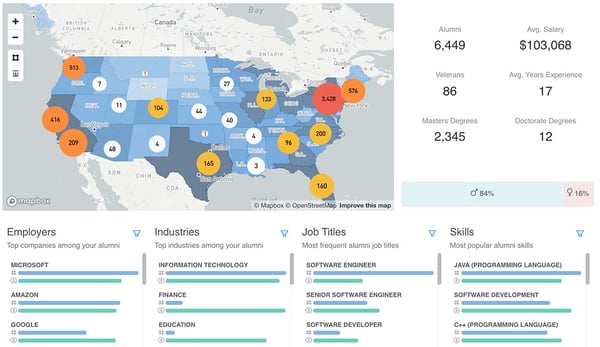It’s been eight months since COVID-19 hit higher education in the U.S. As fall semester ends, the predictions of spring and summer have a few lessons for university leadership as the pandemic continues to rock our institutions.
During the initial lockdown in March, fingers were crossed for a short-term pandemic. Now, the need is clear for long-term crisis management as COVID-19 cases rise and a widespread vaccine isn’t yet available.
Another early prediction cited by The Chronicle of Higher Education is this: “Fall would be a financial bloodbath for colleges … it’s true, most colleges bled money all spring and into the summer — room-and-board refunds, lost revenue from athletics and events, additional expenses from adapting to COVID-19, and more.” The silver lining is that the system didn’t collapse with the blow higher education braced for. Undergraduate enrollment is only 4% below last year’s numbers, according to the National Student Clearinghouse Research Center.
Unfortunately, the impact doesn't look so positive when you break the data down further. Enrollment changes and financial losses vary enormously by institution type.
First-Time Freshman Enrollment Changes, Fall 2020
 The National Student Clearinghouse reports a total decline in freshman enrollment of 13%. The largest declines for freshmen at a national level are concentrated among Native Americans, Hispanic and Black students.
The National Student Clearinghouse reports a total decline in freshman enrollment of 13%. The largest declines for freshmen at a national level are concentrated among Native Americans, Hispanic and Black students.
Community colleges saw the steepest drop at 18.9%, almost 19 times the pre-pandemic loss rate.
Public four-year colleges saw a decline of 10.5%, and private nonprofit four-year institutions dropped 8.5%.
We spoke with Greg Zaiser, Vice President for Enrollment at Elon University, who believes in the cohort model for enrollment and retention. For returning students, being part of a group allows for them to reconnect, engage and become successful on a physically distant (or completely virtual) campus. For recruitment, Elon uses outcomes data to communicate the value of a degree.
"A big challenge for universities has been helping students impacted economically. To support both incoming and continuing students, Elon launched a fundraising effort called Students First — for students directly impacted by COVID-19," Zaiser said. “It’s been critical to assisting many students who might not otherwise have been at Elon this fall. This is a remarkable investment on the part of donors." The university is taking it a step further by removing barriers to admission intensified by COVID-19.
By becoming test-optional, the university is eliminating a barrier that many qualified students now face because of not being able to take the SAT. -Greg Zaiser, “Care Counts in Crisis: College Admissions Deans Respond to COVID-19”
In an interview with Paul Keller, Director of International Enrollment at the Rochester Institute of Technology, he shared they have a marketing communication arm that uses alumni outcomes data to convey value to prospects while at the same time balancing promise with reality in a COVID-19 world.

Alumni Outcomes for Rochester Institute of Technology Computer Science Graduates, Steppingblocks Data Insights
How does Institutional Research fit into the pandemic puzzle?
From reimagining the physical campus to building COVID-19 tracking dashboards Institutional Research teams have been instrumental in navigating the effects of 2020 in higher education.
The Association for Institutional Research (AIR) conducted a survey to learn how IR and IE leaders have expanded their approaches during the pandemic. Here are opportunities respondents reported:
- Leadership roles in institution-wide task forces
- Service as data experts on planning committees
- Provision of data and information in support of pandemic-related changes
- The formalization of previously informal or ad hoc processes
With new responsibilities comes a new set of challenges. AIR’s survey also reports that the pandemic’s greatest impacts on IR include, “...working from home and surges in the number of data requests on short timelines.” To make matters worse, resources are challenged with decreases in personnel — 15% of respondents reported furloughs.
Q&A: What's really happening in IR? We asked.
We wanted to learn more about the challenges and opportunities faced by this department, so we sat down (virtually) with IR directors from all types of institutions to get their perspective on the state of higher education and big data.
Q. What are your main priorities right now, and how has your day-to-day been affected?
Tom Geaghan, Director of IR, Cleveland State University: Over the summer we had to shift away from traditional work in the face of managing a rolling furlough calendar. During that time, we had to pull back on outcomes-related work and new projects to focus more on our core competencies: state and federal reporting and retention and graduation tracking.
Since we have come out of that challenging term, we have actually been quite involved in COVID logistics projects, from helping determine which classes to move to a hybrid model to studying the implications of a move to an opt-in pass/fail grading system.
Nick Stevens, Chief Data Officer, University of Kansas: We are involved in a lot more operations things, like reshuffling the fall schedule by analyzing classroom capacity data or creating new instruction modes that account for course transformation. Surveys that would normally be designed over 3-4 months often now have 24-hour turnaround times.
Jolene Hamm, Director of IR, Piedmont Virginia Community College: The strategic plan is written with fluidity, and our mission hasn’t changed. Our primary goals are Student Success, Academic Rigor, Inclusion and Diversity, and Graduate Employment. Our biggest concern is with transfer students and how four-year institutions will treat pass/not pass grades. Another focus is on students’ needs (i.e., food insecurity, homelessness, and WiFi capabilities at home); unfortunately, the data is not always available for these variables. We want our students to be successful, and we strive to help our students achieve their goals.
Q. Equity, diversity, and inclusion are priorities for IR right now. How does data play a part?
Juan Xu, Director of IR, Clemson University: Filling in the student achievement gap has been a priority at Clemson University, so is increasing representation of underrepresented minority among our students and employees. My team provides data to measure and to inform the progress towards these goals.
Jolene Hamm: Underrepresented populations have always been a huge focus for us. Three years ago, our student population was 29% diverse students. Now, it’s 33%. Each year, we’ve seen an increase in diversity. In order to facilitate success, we identify the most vulnerable groups via data (i.e. GPA and retention), and the College develops a way to bridge the gap effectively.
For the last two years, our mentorship programs have targeted minority and/or at-risk students, specifically African-American males, because at PVCC, the retention rate and GPA for this population are less than PVCC would like for its students to achieve (2.8 minimum GPA). The program results have shown improvement in GPA, but we’re looking to make bigger strides. There is a constant dedication from the mentors to get their mentees through to the finish line, either transfer or graduation. If we had more funding, we would be able to do a better job.
Another resource I'm excited about is the Student Financial Resource Center. The resource center provides access to community and college resources, such as the emergency fund. A program unique to PVCC is Network2Work, a job network that connects people looking for a job with the skills and resources needed by community employers. This helps employers hire quality employees, and ensures individuals are valued for their capabilities.
Q. Student success depends on data-informed decision-making across the campus. During this dynamic time for IR, how have unreliable data lakes and information silos continued to undermine progress?
Tom Geaghan: It’s a real problem. There are a lot of people in the room to make the best decisions possible for staff and students, but a lot of data analysts are not at the table to combat how we measure their metrics. For instance, we have found that data collection is happening around timely issues such as COVID cases and CARES Act spending, but with that even some data is siloed or protected — making certain types of analytical and reporting work difficult.
Juan Xu: In a time of crisis, some decisions need to be made more quickly than usual — data becomes more prominent. Providing accurate, consistent and timely data to inform decision-making is the core mission of our Office for Institutional Research. I think all IR professionals need to step up to help our institutions.
Jolene Hamm: We don’t struggle at all in terms of capturing data — one thing I brought to the institution was alumni employment data. If our alumni work for an employer who is registered with the Virginia Employment Commission (VEC), we get all employment data thanks to the relationship that the Virginia Community College has with the VEC. In addition to the VEC data, we send out two surveys to learn if the skills and attributes we are training our students for are the quality they need to be.
The VEC helps tell us if a graduate got a job, but we don’t know if they keep their job; and if they don’t keep their job, why. As a result, we survey our graduates six months after graduation and ask if the skills we were training them for are appropriate for the job we said we prepared them for. We also want to make sure that these skills are the quality employers want, so we send out an employer survey, which includes satisfaction of skills produced in their program.


Employment data for Piedmont Virginia Community College analyzed by CrowdSegment reflects alumni outcomes for Registered Nurses and includes top employers, industries and demographics.
We also gather status on transfer students from major institutions like the University of Virginia, Virginia Commonwealth University, and Virginia Tech. If we notice a trend in retakes, the Provost and Dean work on a plan of action to make classes transferable.
Q. Can you comment on this statement? EAB conducted a survey to evaluate IR’s priorities and needs. Respondents cited a concern around holes in longitudinal data with many surveys cancelled, courses transformed, and assessments interrupted.
Nick Stevens: True statement. We cancelled most surveys except our graduate student satisfaction survey, which had to be modified to collect only the bare minimum necessary for assessment. Course transformation and campus de-densification required modifying instruction modes, creating additional sections, etc., which will impact our longitudinal trends and year-over-year comparisons.
Juan Xu: A survey respondent may not provide a true answer when under stress. Therefore, the integrity of data collected through quantitative surveys at a time of crisis may be compromised. A qualitative approach to gathering data, like interviews, may be a better approach during these times.
EAB asked: We know the current COVID-19 pandemic has caused significant disruption across university campuses. How is this impacting your team's work?
Q. In terms of collecting longitudinal data on graduate outcomes, are you confident in the data you are gathering and will be able to gather moving forward?
Nick Stevens: During the summer, we focused on the recruitment of the freshman class. Graduate outcomes are still very important to us, and once the disruption from the pandemic is over, we hope to shift our focus back to this critical task
What new data-driven tools were delivered during the pandemic?
At Clemson, new online self-service tools have been developed by the Office for Institutional Research (OIR) and Clemson Computing and Information Technology (CCIT) to ultimately improve student retention and success. The reports help campus administrators monitor and benchmark student and course registrations, student registration, and graduation status. Juan Xu and Joe McLaughlin, Institutional Researcher at Clemson, presented the new reports at Analytics Day hosted by Appalachian State University this past June.
Stony Brook University’s Office of Institutional Research, Planning & Effectiveness (IRPE) developed a public-facing dashboard to display information about COVID-19 on the campus.

Want to understand the state of higher ed at your university? Get your free alumni insights report.
Click here to get a free data snapshot of your university outcomes. Steppingblocks will analyze your institutional alumni from our database of over 100 million real people in the workforce. Understand your impact to prove (and improve) the value of a degree from your university.

%20(1).png)





